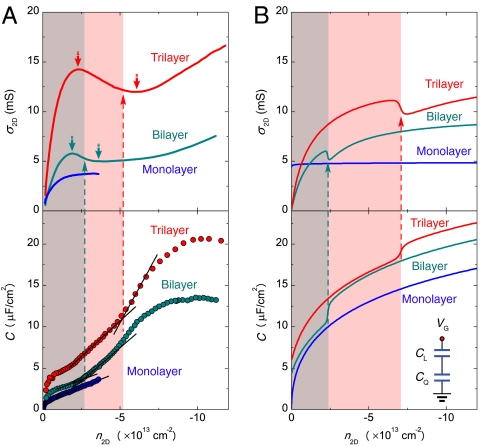Fig. 4.
Theoretical interpretation of the carried density dependence. (A) The experimental data of conductivity σ2D and capacitance  as a function of carrier density n2D for mono-, bi-, and trilayer graphene. The red and cyan pair of arrows point to the conductivity anomaly (nonmonotonic dependence of σ2D on n2D). The dashed lines indicate how the range of densities, at which the conductivity anomalies are observed in bi- and trilayer, corresponds to the values of density where the measured capacitance increases. (B) The results of theoretical simulations for the same quantities plotted in A. In the theoretical calculations, the features observed in the conductivity and in the capacitance are much sharper than that in the experimental data, because of large potential fluctuations in the ionic-liquid gate (due to the presence of high-density molecular ions that are only approximately 1 nm away from the graphene layers) that are not included in the theoretical model. The inset shows the configuration of the total capacitance between ionic liquid and graphene, which consists of the geometrical and quantum capacitances connected in series. To analyze the data theoretically, we have chosen for the geometrical capacitance a realistic value of CL = 40 μF/cm2. Overall, all the qualitative features and trends observed in the experiments are reproduced by the calculations.
as a function of carrier density n2D for mono-, bi-, and trilayer graphene. The red and cyan pair of arrows point to the conductivity anomaly (nonmonotonic dependence of σ2D on n2D). The dashed lines indicate how the range of densities, at which the conductivity anomalies are observed in bi- and trilayer, corresponds to the values of density where the measured capacitance increases. (B) The results of theoretical simulations for the same quantities plotted in A. In the theoretical calculations, the features observed in the conductivity and in the capacitance are much sharper than that in the experimental data, because of large potential fluctuations in the ionic-liquid gate (due to the presence of high-density molecular ions that are only approximately 1 nm away from the graphene layers) that are not included in the theoretical model. The inset shows the configuration of the total capacitance between ionic liquid and graphene, which consists of the geometrical and quantum capacitances connected in series. To analyze the data theoretically, we have chosen for the geometrical capacitance a realistic value of CL = 40 μF/cm2. Overall, all the qualitative features and trends observed in the experiments are reproduced by the calculations.

